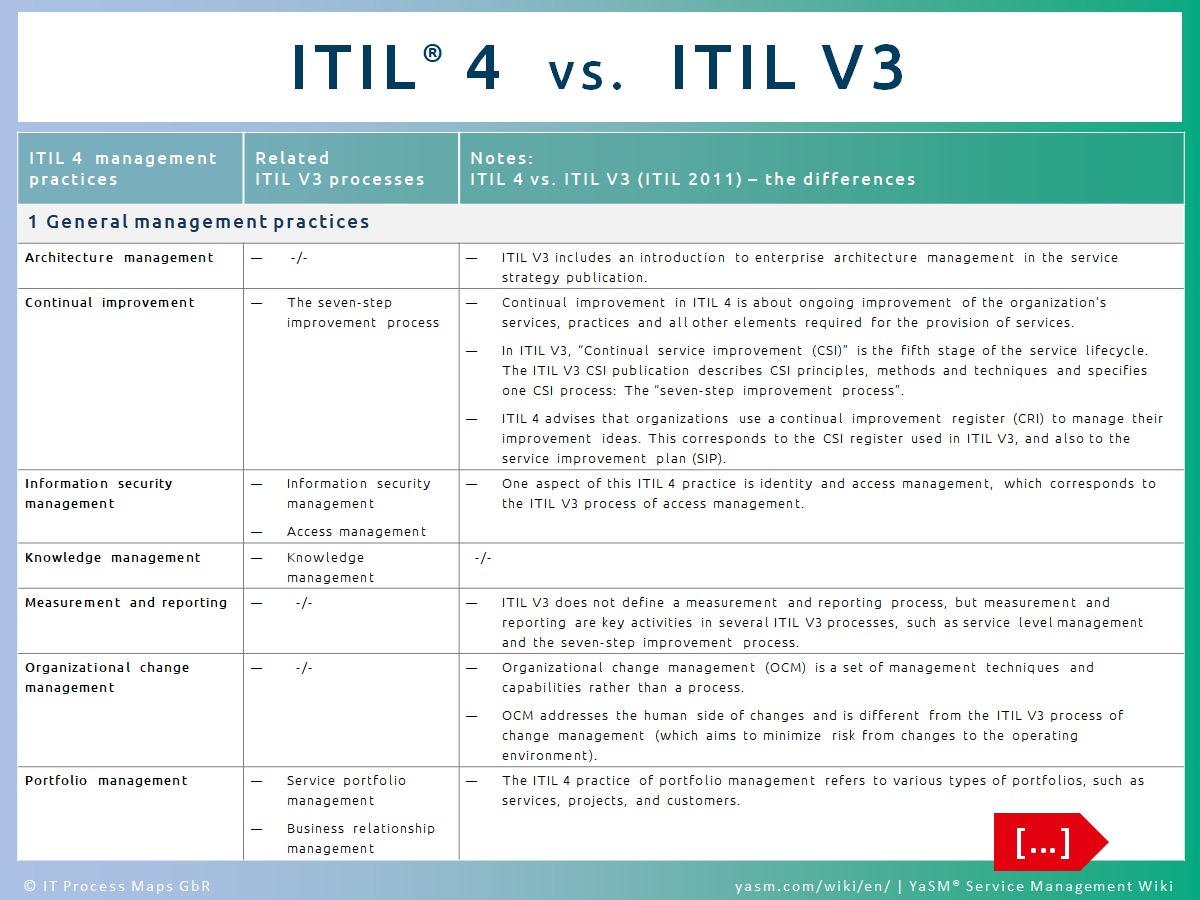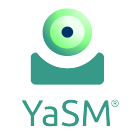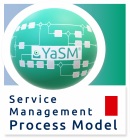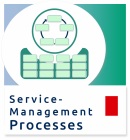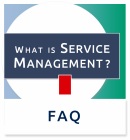ITIL 4 vs ITIL V3: Difference between revisions
Created page with "<itpmch><title>ITIL 4 vs. ITIL V3 | YaSM Wiki</title> <meta name="keywords" content="itil 4 vs itil v3, itil 4 vs itil 3, itil 4, itil 4 differences" /> <meta name="descriptio..." |
No edit summary |
||
| Line 1: | Line 1: | ||
<itpmch><title> | <itpmch><title>ITIL® 4 vs. ITIL V3 | YaSM Service Management Wiki</title> | ||
<meta name="keywords" content="itil 4 vs itil v3, itil 4 vs itil 3, itil 4, itil 4 differences" /> | <meta name="keywords" content="itil 4 vs itil v3, itil 4 vs itil 3, itil 4, itil 4 differences" /> | ||
<meta name="description" content="ITIL 4 vs ITIL V3: What is new in the current ITIL version 'ITIL 4'? The main differences: ITIL 4 content vs. ITIL V3 elements. Comparison: ITIL 4 practices and ITIL V3 processes. This page describes in detail where ITIL 4 has added new guidance, and how the contents in ITIL 4 can be traced back to specific elements of ITIL V3." /> | <meta name="description" content="ITIL 4 vs ITIL V3: What is new in the current ITIL version 'ITIL 4'? The main differences: ITIL 4 content vs. ITIL V3 elements. Comparison: ITIL 4 practices and ITIL V3 processes. This page describes in detail where ITIL 4 has added new guidance, and how the contents in ITIL 4 can be traced back to specific elements of ITIL V3." /> | ||
<meta property="og:url" content="https://yasm.com/wiki/en/index.php/ITIL_4_vs_ITIL_V3" /> | <meta property="og:url" content="https://yasm.com/wiki/en/index.php/ITIL_4_vs_ITIL_V3" /> | ||
<meta property="og:title" content=" | <meta property="og:title" content="ITIL® 4 vs. ITIL V3 | YaSM Service Management Wiki" /> | ||
<meta property="og:description" content="This page describes in detail where ITIL 4 has added new guidance, and how the contents in ITIL 4 can be traced back to specific elements of ITIL V3." /> | <meta property="og:description" content="Organizations that need to plan their transition to the latest edition of ITIL® will require a detailed mapping between ITIL V3 and ITIL 4: This page describes in detail where ITIL 4 has added new guidance, and how the contents in ITIL 4 can be traced back to specific elements of ITIL V3 2011." /> | ||
<meta property="og:site_name" content="YaSM"> | <meta property="og:site_name" content="YaSM"> | ||
<meta property="og:type" content="article" /> | <meta property="og:type" content="article" /> | ||
| Line 10: | Line 10: | ||
<meta property="fb:admins" content="100002035253209" /> | <meta property="fb:admins" content="100002035253209" /> | ||
<meta property="fb:admins" content="100002592864414" /> | <meta property="fb:admins" content="100002592864414" /> | ||
<meta property="og:image" content="https://yasm.com/wiki/en/img/yasm-frameworks/itil/ | <meta property="og:image" content="https://yasm.com/wiki/en/img/yasm-frameworks/itil/16x9/itil-4-vs-itil-v3-list.jpg" /> | ||
<meta property="og:image:width" content="1200" /> | <meta property="og:image:width" content="1200" /> | ||
<meta property="og:image:height" content=" | <meta property="og:image:height" content="675" /> | ||
<meta property="og:image" content="https://yasm.com/wiki/en/img/yasm-frameworks/itil/itil-4-vs-itil-v3-list.jpg" /> | <meta property="og:image" content="https://yasm.com/wiki/en/img/yasm-frameworks/itil/itil-4-vs-itil-v3-list.jpg" /> | ||
<meta property="og:image:width" content="1200" /> | <meta property="og:image:width" content="1200" /> | ||
| Line 19: | Line 19: | ||
<meta name="twitter:site" content="@yasmcom"> | <meta name="twitter:site" content="@yasmcom"> | ||
<meta name="twitter:creator" content="@yasmcom"> | <meta name="twitter:creator" content="@yasmcom"> | ||
<meta name="twitter:title" content=" | <meta name="twitter:title" content="ITIL® 4 vs. ITIL V3 | YaSM Wiki"> | ||
<meta name="twitter:description" content=" | <meta name="twitter:description" content="Details: Where ITIL 4 has added new guidance, and how the contents in ITIL 4 can be traced back to specific elements of ITIL V3."> | ||
<meta name="twitter:image" content="https://yasm.com/wiki/en/img/yasm-frameworks/itil/ | <meta name="twitter:image" content="https://yasm.com/wiki/en/img/yasm-frameworks/itil/16x9/itil-4-vs-itil-v3-list.jpg"> | ||
<meta name="twitter:image:alt" content="ITIL 4 vs ITIL V3: Where ITIL | <meta name="twitter:image:alt" content="ITIL 4 vs ITIL V3: Where ITIL 4® has added new guidance, and how the contents in ITIL 4 can be traced back to specific elements of ITIL V3. Detailed mapping between ITIL 3 and ITIL 4. ITIL 4 practices and ITIL V3 processes: How the ITIL 4 practices map to the service lifecycle processes known from ITIL V3."> | ||
<link href="https://plus.google.com/104150539756444616711/posts" rel="publisher" /> | <link href="https://plus.google.com/104150539756444616711/posts" rel="publisher" /> | ||
<meta name="pinterest-rich-pin" content="false" /> | <meta name="pinterest-rich-pin" content="false" /> | ||
| Line 43: | Line 43: | ||
<meta itemprop="dateCreated" content="2019-03-16" /> | <meta itemprop="dateCreated" content="2019-03-16" /> | ||
<meta itemprop="datePublished" content="2019-03-16" /> | <meta itemprop="datePublished" content="2019-03-16" /> | ||
</span> | |||
<span itemprop="thumbnail" itemscope itemtype="https://schema.org/ImageObject"> | |||
<meta itemprop="url" content="https://yasm.com/wiki/en/img/yasm-frameworks/itil/16x9/itil-4-vs-itil-v3-list.jpg" /> | |||
<meta itemprop="width" content="1200" /> | |||
<meta itemprop="height" content="675" /> | |||
<meta itemprop="dateCreated" content="2019-03-16" /> | |||
<meta itemprop="datePublished" content="2019-03-17" /> | |||
</span> | </span> | ||
<meta itemprop="keywords" content="ITIL 4 ITIL v3" /> | <meta itemprop="keywords" content="ITIL 4 ITIL v3" /> | ||
<meta itemprop="keywords" content="ITIL 4 ITIL 2011" /> | <meta itemprop="keywords" content="ITIL 4 ITIL 2011" /> | ||
<meta itemprop="keywords" content="ITIL 4 differences" /> | <meta itemprop="keywords" content="ITIL 4 differences" /> | ||
<img style="margin:5px 0px 30px 30px; float:right;" src="https://yasm.com/wiki/en/img/yasm-frameworks/itil/4x3/itil-4-vs-itil-v3-list.jpg" width="400" height="300" title="ITIL 4 vs. ITIL V3. Comparison: ITIL 4 practices and ITIL V3 processes" alt="Detailed mapping between ITIL V3 and ITIL 4. ITIL 4 practices and ITIL V3 processes: How the ITIL 4 practices map to the service lifecycle processes known from ITIL V3." /></a></div></html> | <img style="margin:5px 0px 30px 30px; float:right;" src="https://yasm.com/wiki/en/img/yasm-frameworks/itil/4x3/itil-4-vs-itil-v3-list.jpg" width="400" height="300" title="ITIL 4 vs. ITIL V3. Comparison: ITIL 4 practices and ITIL V3 processes" alt="Detailed mapping between ITIL V3 and ITIL 4. ITIL 4 practices and ITIL V3 processes: How the ITIL 4 practices map to the service lifecycle processes known from ITIL V3." /></a></div> | ||
<p><span id="md-webpage-description" itemprop="description">Organizations that need to plan their transition to the latest edition of ITIL<sup><small>®</small></sup> <sup><a href="#ITIL" title="ITIL trademark">[1]</a></sup> will require a detailed mapping between ITIL V3 and ITIL 4: This page describes in detail where ITIL 4 has added new guidance, and how the contents in ITIL 4 can be traced back to specific elements of ITIL V3 2011.</span></html> | |||
<p> </p> | |||
__TOC__ | |||
ITIL 4 | ===ITIL 4: What's new?=== | ||
---- | |||
ITIL 4 - the most current edition of ITIL<sup><small>®</small></sup> <sup>[[#ITIL|[1]]]</sup> - was officially released in February 2019. As AXELOS state, "ITIL 4 expands on previous versions by providing a practical and flexible basis to support organizations on their journey to the new world of digital transformation". | |||
ITIL 4 is thus an evolution of the familiar ITIL framework rather than a revolution, and still uses many [[#ITIL_4_components_vs._ITIL_V3|fundamental elements]] from the previous version ITIL V3, as first published in 2007 and updated in 2011 ("ITIL 2011"). In particular, many of the new [[#ITIL_4_practices_vs._ITIL_V3_processes|ITIL 4 practices correspond to processes known from ITIL V3]]. | |||
<p> </p> | <p> </p> | ||
| Line 61: | Line 72: | ||
{| class="wikitable" style="background: white;" | {| class="wikitable" style="background: white;" | ||
|+style="background:#379988;"|<h3 style="color:#ffffff;">ITIL 4 | |+style="background:#379988;"|<h3 style="color:#ffffff;">ITIL 4 components vs. ITIL V3</h3> | ||
|-style="vertical-align:top" | |-style="vertical-align:top" | ||
!style="background:#379988; font-size: 110%; color:#ffffff; width:25%; text-align:left;"|ITIL 4 | !style="background:#379988; font-size: 110%; color:#ffffff; width:25%; text-align:left;"|ITIL 4 component <sup>[[#ITIL-4-content|[2]]]</sup> | ||
!style="background:#379988; font-size: 110%; color:#ffffff; width:75%; text-align:left;"|New content in ITIL 4 and how it relates to ITIL V3 <sup>[[#ITIL-2011-content|[3]]]</sup> | !style="background:#379988; font-size: 110%; color:#ffffff; width:75%; text-align:left;"|Comparison: New content in ITIL 4 and how it relates to ITIL V3 <sup>[[#ITIL-2011-content|[3]]]</sup> | ||
|- | |- | ||
|-style="background:#eeeeee; vertical-align:top; text-align:left; " | |-style="background:#eeeeee; vertical-align:top; text-align:left; " | ||
| Line 106: | Line 117: | ||
| | | | ||
* The ITIL 4 guiding principles are universal recommendations that can guide organizations in many situations, such as "work holistically" and "keep it simple and practical". | * The ITIL 4 guiding principles are universal recommendations that can guide organizations in many situations, such as "work holistically" and "keep it simple and practical". | ||
* These guiding principles are not part of the original ITIL V3 publications, but they have been adopted from [https://www.axelos.com/store/book/itil-practitioner-guidance ITIL<sup><small>®</small></sup> Practitioner], a more recent addition to the ITIL V3 portfolio. | * These guiding principles are not part of the original ITIL V3 publications, but they have been adopted from [https://www.axelos.com/store/book/itil-practitioner-guidance ITIL<sup><small>®</small></sup> Practitioner], a more recent addition to the ITIL V3 portfolio. | ||
|-style="vertical-align:top" | |-style="vertical-align:top" | ||
|<h5>Governance</h5> | |<h5>Governance</h5> | ||
| Line 162: | Line 173: | ||
* ITIL 4 includes updated guidance on multi-sourcing and service integration. These are key topics in the [[SIAM]]<sup><small>®</small></sup><sup>[[#SIAM|[5]]]</sup> framework. | * ITIL 4 includes updated guidance on multi-sourcing and service integration. These are key topics in the [[SIAM]]<sup><small>®</small></sup><sup>[[#SIAM|[5]]]</sup> framework. | ||
* ITIL 4 embraces new ways of working, such as [[YaSM_and_Agile_Service_Management|Agile]], [[YaSM_and_Lean_Service_Management|Lean]] and [[DevOps_and_YaSM|DevOps]], as well as organizational change management. These management practices and their relevance for service management are also described in the [[VeriSM|VeriSM]]™<sup>[[#VeriSM|[6]]]</sup> approach. | * ITIL 4 embraces new ways of working, such as [[YaSM_and_Agile_Service_Management|Agile]], [[YaSM_and_Lean_Service_Management|Lean]] and [[DevOps_and_YaSM|DevOps]], as well as organizational change management. These management practices and their relevance for service management are also described in the [[VeriSM|VeriSM]]™<sup>[[#VeriSM|[6]]]</sup> approach. | ||
* The ITIL 4 service value chain is somewhat reminiscent of the VeriSM model, with key areas such as define, produce, provide and respond. | * The ITIL 4 service value chain is somewhat reminiscent of the VeriSM™ model, with key areas such as define, produce, provide and respond. | ||
* ITIL 4 introduces the concept of a service value system. This fits in with a key requirement in [[ISO_20000_-_2018|the latest 2018 edition of ISO 20000]] for organizations to "establish, implement, maintain and continually improve" a service management system. | * ITIL 4 introduces the concept of a service value system. This fits in with a key requirement in [[ISO_20000_-_2018|the latest 2018 edition of ISO 20000]] for organizations to "establish, implement, maintain and continually improve" a service management system. | ||
<p> </p> | <p> </p> | ||
| Line 168: | Line 179: | ||
==ITIL 4 practices vs. ITIL V3 processes== | ==ITIL 4 practices vs. ITIL V3 processes== | ||
<html>The tables below | <html>The tables below provide a detailed account of how the ITIL 4 practices map to the service lifecycle processes known from ITIL V3 (see <a href="https://yasm.com/wiki/en/img/yasm-frameworks/itil/itil-4-vs-itil-v3-list.jpg" title="ITIL 4 vs. ITIL V3 (ITIL 2011): Differences">fig. 1</a>):</html> | ||
* [[#General_management_practices|General management practices]] | * [[#General_management_practices|General management practices]] | ||
| Line 180: | Line 191: | ||
!style="background:#eeeeee; width:20%"|ITIL 4 management practices<sup>[[#ITIL-4-practices|[7]]]</sup> | !style="background:#eeeeee; width:20%"|ITIL 4 management practices<sup>[[#ITIL-4-practices|[7]]]</sup> | ||
!style="background:#eeeeee; width:20%"|Related ITIL V3 processes <sup>[[#ITIL-2011-processes|[8]]]</sup> | !style="background:#eeeeee; width:20%"|Related ITIL V3 processes <sup>[[#ITIL-2011-processes|[8]]]</sup> | ||
!style="background:#eeeeee; width:60%"| | !style="background:#eeeeee; width:60%"|ITIL 4 vs. ITIL V3: The changes | ||
|-style="vertical-align:top" | |-style="vertical-align:top" | ||
|Architecture management | |Architecture management | ||
| Line 281: | Line 292: | ||
!style="background:#eeeeee; width:20%"|ITIL 4 management practices | !style="background:#eeeeee; width:20%"|ITIL 4 management practices | ||
!style="background:#eeeeee; width:20%"|Related ITIL V3 processes | !style="background:#eeeeee; width:20%"|Related ITIL V3 processes | ||
!style="background:#eeeeee; width:60%"| | !style="background:#eeeeee; width:60%"|ITIL 4 vs. ITIL V3: The changes | ||
|-style="vertical-align:top" | |-style="vertical-align:top" | ||
|Availability management | |Availability management | ||
| Line 398: | Line 409: | ||
!style="background:#eeeeee; width:20%"|ITIL 4 management practices | !style="background:#eeeeee; width:20%"|ITIL 4 management practices | ||
!style="background:#eeeeee; width:20%"|Related ITIL V3 processes | !style="background:#eeeeee; width:20%"|Related ITIL V3 processes | ||
!style="background:#eeeeee; width:60%"| | !style="background:#eeeeee; width:60%"|ITIL 4 vs. ITIL V3: The changes | ||
|-style="vertical-align:top" | |-style="vertical-align:top" | ||
|Deployment management | |Deployment management | ||
| Line 426: | Line 437: | ||
==References== | ==References== | ||
<span id="ref-axelos-2019">[AXELOS, 2019]. -- AXELOS: ITIL<sup><small>®</small></sup> Foundation, ITIL 4 Edition. - The Stationery Office; Norwich, UK, February 2019.</span><br /> | |||
[a] <span id="ref-cabinet-office-2011a">[Cabinet Office, 2011a]. -- The Cabinet Office: ITIL<sup><small>®</small></sup> Service Strategy (2011 Edition). - The Stationery Office; London, UK, July 2011.</span><br /> | [a] <span id="ref-cabinet-office-2011a">[Cabinet Office, 2011a]. -- The Cabinet Office: ITIL<sup><small>®</small></sup> Service Strategy (2011 Edition). - The Stationery Office; London, UK, July 2011.</span><br /> | ||
[b] <span id="ref-cabinet-office-2011b">[Cabinet Office, 2011b]. -- The Cabinet Office: ITIL<sup><small>®</small></sup> Service Design (2011 Edition). - The Stationery Office; London, UK, July 2011.</span><br /> | [b] <span id="ref-cabinet-office-2011b">[Cabinet Office, 2011b]. -- The Cabinet Office: ITIL<sup><small>®</small></sup> Service Design (2011 Edition). - The Stationery Office; London, UK, July 2011.</span><br /> | ||
| Line 444: | Line 456: | ||
[8] <span id="ITIL-2011-processes">The ITIL V3 processes in this table are based on ITIL V3 2011. | [8] <span id="ITIL-2011-processes">The ITIL V3 processes in this table are based on ITIL V3 2011. | ||
<html>By:  Stefan Kempter <a | <html>By:  Stefan Kempter <a href="https://www.linkedin.com/in/stefankempter"><img style="margin:0px 0px 0px 0px;" src="/wiki/en/img/yasm-wiki/bookmarking/linkedin.jpg" width="16" height="16" title="By: Stefan Kempter | Profile on LinkedIn" alt="Author: Stefan Kempter, IT Process Maps GbR" /></a>  and  Andrea Kempter <a href="https://www.linkedin.com/in/andreakempter"><img style="margin:0px 0px 0px 0px;" src="/wiki/en/img/yasm-wiki/bookmarking/linkedin.jpg" width="16" height="16" title="By: Andrea Kempter | Profile on LinkedIn" alt="Contributor: Andrea Kempter, IT Process Maps GbR" /></a>, IT Process Maps. | ||
<p> </p> | <p> </p> | ||
| Line 450: | Line 462: | ||
<span itemprop="breadcrumb" itemscope itemtype="http://schema.org/BreadcrumbList"> | <span itemprop="breadcrumb" itemscope itemtype="http://schema.org/BreadcrumbList"> | ||
<span itemprop="itemListElement" itemscope itemtype="http://schema.org/ListItem"> | <span itemprop="itemListElement" itemscope itemtype="http://schema.org/ListItem"> | ||
<a itemprop="item" href="https://yasm.com/wiki/en/index.php/ITIL_4_vs_ITIL_V3# | <a itemprop="item" href="https://yasm.com/wiki/en/index.php/ITIL_4_vs_ITIL_V3#ITIL_4:_What.27s_new.3F"> <span itemprop="name">ITIL 4: What's new?</span></a> | ||
<meta itemprop="position" content="1" /></span> › | <meta itemprop="position" content="1" /></span> › | ||
<span itemprop="itemListElement" itemscope itemtype="http://schema.org/ListItem"> | <span itemprop="itemListElement" itemscope itemtype="http://schema.org/ListItem"> | ||
<a itemprop="item" href="https://yasm.com/wiki/en/index.php/ITIL_4_vs_ITIL_V3# | <a itemprop="item" href="https://yasm.com/wiki/en/index.php/ITIL_4_vs_ITIL_V3#ITIL_4_components_vs._ITIL_V3"> <span itemprop="name">ITIL 4 components vs. ITIL V3</span></a> | ||
<meta itemprop="position" content="2" /></span> › | <meta itemprop="position" content="2" /></span> › | ||
<span itemprop="itemListElement" itemscope itemtype="http://schema.org/ListItem"> | <span itemprop="itemListElement" itemscope itemtype="http://schema.org/ListItem"> | ||
<a itemprop="item" href="https://yasm.com/wiki/en/index.php/ITIL_4_vs_ITIL_V3# | <a itemprop="item" href="https://yasm.com/wiki/en/index.php/ITIL_4_vs_ITIL_V3#Has_ITIL_4_dropped_the_ITIL_V3_service_lifecycle.3F"> <span itemprop="name">Service lifecycle in ITIL 4</span></a> | ||
<meta itemprop="position" content="3" /></span> › | <meta itemprop="position" content="3" /></span> › | ||
<span itemprop="itemListElement" itemscope itemtype="http://schema.org/ListItem"> | |||
<a itemprop="item" href="https://yasm.com/wiki/en/index.php/ITIL_4_vs_ITIL_V3#Where_in_ITIL_4_are_the_ITIL_V3_processes.3F"> <span itemprop="name">ITIL 4 processes</span></a> | |||
<meta itemprop="position" content="4" /></span> › | |||
<span itemprop="itemListElement" itemscope itemtype="http://schema.org/ListItem"> | <span itemprop="itemListElement" itemscope itemtype="http://schema.org/ListItem"> | ||
<a itemprop="item" href="https://yasm.com/wiki/en/index.php/ITIL_4_vs_ITIL_V3#ITIL_4_practices_vs._ITIL_V3_processes"> <span itemprop="name">ITIL 4 practices vs. ITIL V3 processes</span></a> | <a itemprop="item" href="https://yasm.com/wiki/en/index.php/ITIL_4_vs_ITIL_V3#ITIL_4_practices_vs._ITIL_V3_processes"> <span itemprop="name">ITIL 4 practices vs. ITIL V3 processes</span></a> | ||
<meta itemprop="position" content=" | <meta itemprop="position" content="5" /></span> | ||
</span> | </span> | ||
</small></p> | </small></p> | ||
<!-- define schema.org/WebPage --> <span itemid="https://yasm.com/wiki/en/index.php/ITIL_4_vs_ITIL_V3" itemscope itemtype="https://schema.org/WebPage" itemref="md-webpage-description"> | <!-- define schema.org/WebPage --> <span itemid="https://yasm.com/wiki/en/index.php/ITIL_4_vs_ITIL_V3" itemscope itemtype="https://schema.org/WebPage" itemref="md-webpage-description"> | ||
<meta itemprop="name Headline" content="ITIL | <meta itemprop="name Headline" content="ITIL 4® vs. ITIL V3" /> | ||
<meta itemprop="alternativeHeadline" content="Comparison: ITIL 4 and ITIL 3" /> | <meta itemprop="alternativeHeadline" content="Comparison: ITIL 4 and ITIL 3" /> | ||
<meta itemprop="alternativeHeadline" content="ITIL 4 vs. ITIL 2011" /> | |||
<link itemprop="url" href="https://yasm.com/wiki/en/index.php/ITIL_4_vs_ITIL_V3" /> | <link itemprop="url" href="https://yasm.com/wiki/en/index.php/ITIL_4_vs_ITIL_V3" /> | ||
<link itemprop="primaryImageOfPage" href="https://yasm.com/wiki/en/img/yasm-frameworks/itil/itil-4-vs-itil-v3-list.jpg" /> | <link itemprop="primaryImageOfPage" href="https://yasm.com/wiki/en/img/yasm-frameworks/itil/itil-4-vs-itil-v3-list.jpg" /> | ||
Revision as of 13:22, 17 March 2019
Organizations that need to plan their transition to the latest edition of ITIL® [1] will require a detailed mapping between ITIL V3 and ITIL 4: This page describes in detail where ITIL 4 has added new guidance, and how the contents in ITIL 4 can be traced back to specific elements of ITIL V3 2011.
ITIL 4: What's new?
ITIL 4 - the most current edition of ITIL® [1] - was officially released in February 2019. As AXELOS state, "ITIL 4 expands on previous versions by providing a practical and flexible basis to support organizations on their journey to the new world of digital transformation".
ITIL 4 is thus an evolution of the familiar ITIL framework rather than a revolution, and still uses many fundamental elements from the previous version ITIL V3, as first published in 2007 and updated in 2011 ("ITIL 2011"). In particular, many of the new ITIL 4 practices correspond to processes known from ITIL V3.
| ITIL 4 component [2] | Comparison: New content in ITIL 4 and how it relates to ITIL V3 [3] |
|---|---|
ITIL 4 key concepts | |
| Key concepts of service management |
|
ITIL 4 four dimensions model | |
| The four dimensions of service management |
|
ITIL 4 service value system (SVS) | |
| Service value system overview |
|
Guiding principles |
|
Governance |
|
Service value chain |
|
Continual improvement |
|
ITIL 4 practices |
|
Has ITIL 4 dropped the ITIL V3 service lifecycle?
A key innovation of ITIL V3 was the introduction of the service lifecycle, consisting of five service lifecycle stages (service strategy, service design, service transition, service operation and continual service improvement). The ITIL V3 processes are distributed across this service lifecycle; for instance, the incident management process is part of the service operation stage.
The idea behind organizing the ITIL processes in this way was to establish a Deming-like plan-do-check-act cycle focused on continual improvement.
ITIL 4 has dropped most references to the service lifecycle, but continual improvement has remained a key concept. For example, continual improvement is an element of the ITIL 4 service value system, and the ITIL 4 service value chain with its six activities (plan, improve, engage, design and transition, obtain/build, deliver and support) is very reminiscent of the ITIL V3 service lifecycle.
Where in ITIL 4 are the ITIL V3 processes?
ITIL V3 defines 26 processes across the service lifecycle. In ITIL 4, these 26 processes have been replaced by 34 "practices". Some of them are new, but many of the ITIL 4 practices were formerly known as ITIL V3 processes (for a detailed cross-reference, see: ITIL 4 practices vs. ITIL V3 processes).
So the ITIL V3 processes are still alive, and what is more, the authors of ITIL 4 state that ITIL V3 is still valid guidance that can be used for defining service management processes. But it is also worth noting that ITIL 4 is not prescriptive about processes, and gives service providers more freedom to design tailor-made processes that work for the organization.
This presents an opportunity for a fresh start with ITIL processes, in line with the advice in ITIL 4 to "keep things simple and practical": The YaSM®[4] process model describes a streamlined, clear-cut set of service management processes that is a good match for the leaner, more flexible operating models favored by today's service provider organizations.
ITIL 4 and ISO 20000, SIAM®, VeriSM™, …
ITIL is some 30 years old and over the years has been adopted by a large number of organizations. It has been updated from time to time, but other, newer service management frameworks and approaches have been quicker in recognizing emerging trends in service management and information technology. ITIL 4 has arguably taken a leaf or two out of these frameworks to keep up with the times. Here are a few examples:
- ITIL 4 includes updated guidance on multi-sourcing and service integration. These are key topics in the SIAM®[5] framework.
- ITIL 4 embraces new ways of working, such as Agile, Lean and DevOps, as well as organizational change management. These management practices and their relevance for service management are also described in the VeriSM™[6] approach.
- The ITIL 4 service value chain is somewhat reminiscent of the VeriSM™ model, with key areas such as define, produce, provide and respond.
- ITIL 4 introduces the concept of a service value system. This fits in with a key requirement in the latest 2018 edition of ISO 20000 for organizations to "establish, implement, maintain and continually improve" a service management system.
ITIL 4 practices vs. ITIL V3 processes
The tables below provide a detailed account of how the ITIL 4 practices map to the service lifecycle processes known from ITIL V3 (see fig. 1):
| ITIL 4 management practices[7] | Related ITIL V3 processes [8] | ITIL 4 vs. ITIL V3: The changes |
|---|---|---|
| Architecture management |
|
|
| Continual improvement |
|
|
| Information security management |
|
|
| Knowledge management |
|
|
| Measurement and reporting |
|
|
| Organizational change management |
|
|
| Portfolio management |
|
|
| Project management |
|
|
| Relationship management |
|
|
| Risk management |
|
|
| Service financial management |
|
|
| Strategy management |
|
|
| Supplier management |
|
|
| Workforce and talent management |
|
|
| ITIL 4 management practices | Related ITIL V3 processes | ITIL 4 vs. ITIL V3: The changes |
|---|---|---|
| Availability management |
|
|
| Business analysis |
|
|
| Capacity and performance management |
|
|
| Change control |
|
|
| Incident management |
|
|
| IT asset management |
|
|
| Monitoring and event management |
|
|
| Problem management |
|
|
| Release management |
|
|
| Service catalogue management |
|
|
| Service configuration management |
|
|
| Service continuity management |
|
|
| Service design |
|
|
| Service desk |
|
|
| Service level management |
|
|
| Service request management |
|
|
| Service validation and testing |
|
|
| ITIL 4 management practices | Related ITIL V3 processes | ITIL 4 vs. ITIL V3: The changes |
|---|---|---|
| Deployment management |
|
|
| Infrastructure and platform management |
|
|
| Software development and management |
|
|
References
[AXELOS, 2019]. -- AXELOS: ITIL® Foundation, ITIL 4 Edition. - The Stationery Office; Norwich, UK, February 2019.
[a] [Cabinet Office, 2011a]. -- The Cabinet Office: ITIL® Service Strategy (2011 Edition). - The Stationery Office; London, UK, July 2011.
[b] [Cabinet Office, 2011b]. -- The Cabinet Office: ITIL® Service Design (2011 Edition). - The Stationery Office; London, UK, July 2011.
[c] [Cabinet Office, 2011c]. -- The Cabinet Office: ITIL® Service Transition (2011 Edition). - The Stationery Office; London, UK, July 2011.
[d] [Cabinet Office, 2011d]. -- The Cabinet Office: ITIL® Service Operation (2011 Edition). - The Stationery Office; London, UK, July 2011.
[e] [Cabinet Office, 2011e]. -- The Cabinet Office: ITIL® Continual Service Improvement (2011 Edition). - The Stationery Office; London, UK, July 2011.
Notes
[1] ITIL® is a registered trade mark of AXELOS Limited.
[2] The ITIL 4 content referenced in this table is based on ITIL 4 Foundation, published in February 2019.
[3] The ITIL V3 content referenced in this table is based on the 2011 edition of ITIL V3.
[4] YaSM® is a registered trademark of IT Process Maps GbR.
[5] SIAM® is a registered trademark of EXIN.
[6] VeriSM™ is a registered trademark of IFDC.
[7] The management practices in this table are based on ITIL 4 Foundation, published in February 2019.
[8] The ITIL V3 processes in this table are based on ITIL V3 2011.
By: Stefan Kempter ![]() and Andrea Kempter
and Andrea Kempter ![]() , IT Process Maps.
, IT Process Maps.
ITIL 4: What's new? › ITIL 4 components vs. ITIL V3 › Service lifecycle in ITIL 4 › ITIL 4 processes › ITIL 4 practices vs. ITIL V3 processes
